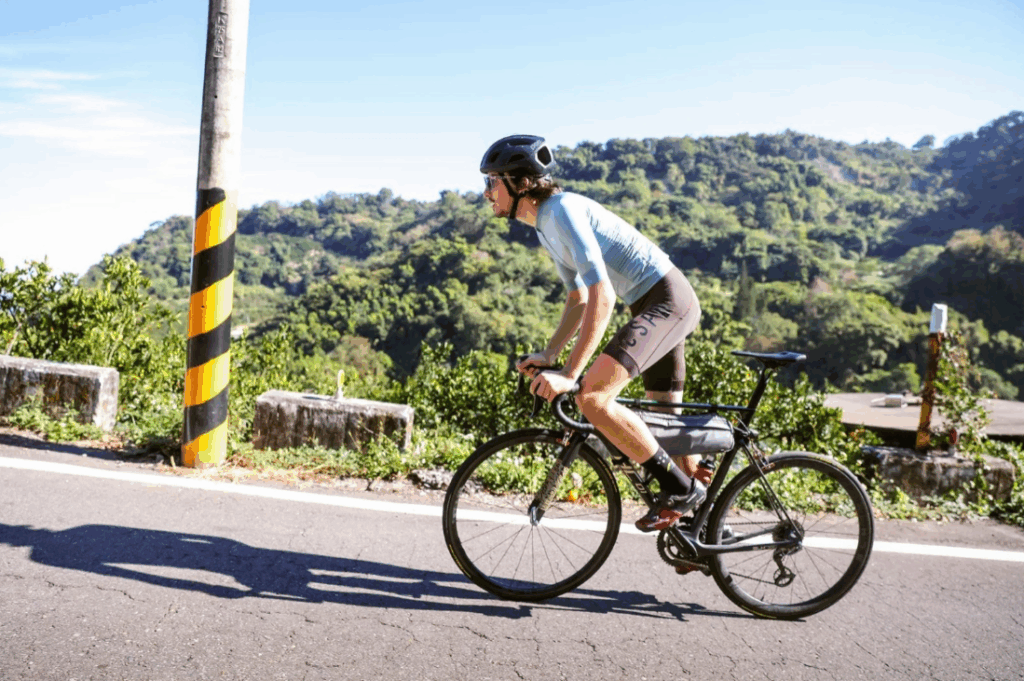Cycling Uphill without losing your breath, maintain a higher cadence (80-90 RPM) and shift gears early before you need them. Focus on diaphragmatic breathing synchronized with your pedal stroke, and keep your upper body relaxed with your hands positioned on the hoods to open your diaphragm. Break climbs into manageable segments mentally and apply power throughout the entire pedal stroke.
These techniques form just the foundation of becoming a stronger, more efficient climber.
Perfect Your Pedaling Technique for Maximum Efficiency
The foundation of efficient uphill cycling lies in your pedal stroke. Maintaining a higher pedaling cadence (80-90 RPM) reduces the strain on your muscles and cardiovascular system, allowing you to breathe more consistently. Focus on applying power throughout the entire stroke, not just pushing down.
Your climbing posture directly impacts cycling efficiency. Keep your upper body relaxed with a slight forward lean, hands on the hoods or tops. This position opens your diaphragm, improving your breathing technique during ascents.
Remember that muscle endurance develops through consistent practice. Start with shorter climbs at a manageable cadence, gradually increasing duration as your technique improves. When you feel breathless, downshift to an easier gear rather than slowing your cadence. Your lungs will thank you.

Master Breathing and Oxygen Management on Climbs
While your legs push the pedals, your lungs ultimately power your climb. Mastering your breathing techniques can dramatically improve your uphill performance. Practice diaphragmatic breathing rather than shallow chest breathing that limits oxygen intake.
Sync your breathing with your climbing rhythm by establishing a consistent inhalation-exhalation pattern that matches your cadence. As you develop better oxygen control, you’ll notice improved endurance on longer ascents.
Incorporate specific endurance training that mimics climbing conditions to adapt your respiratory system to the demands of hills. Don’t neglect your recovery strategy. Learning to normalize your breathing during brief flat sections will help you tackle multi-peak routes without fatigue. Remember: controlled breathing equals sustained power.

Strategic Gearing: Shift Smart to Conserve Energy
Mastering your bike’s gearing system can make the difference between conquering a climb and walking your bike uphill in defeat. Your power-to-weight ratio determines climbing potential, but smart gear shifts maximize what you’ve got. Anticipate gradient changes and shift before you need to, when you’re still maintaining momentum.
Downshift early to maintain a cadence of 70-90 RPM, which optimizes cardiovascular fitness while preventing muscle fatigue. Remember, efficient energy management means never grinding in a gear that’s too hard. Each labored pedal stroke depletes precious oxygen reserves.
Incorporate hill training sessions that practice timed gear changes on varied gradients. It builds muscle memory for shifting while under cardiovascular stress. You’ll soon develop an intuitive feel for when to shift, conserving energy for the steepest sections.

Build Hill-Specific Strength and Endurance
Because regular flat-terrain cycling doesn’t fully prepare you for the demands of climbing, developing hill-specific fitness requires targeted training. Incorporate hill repeats into your routine. Find a moderate gradient and climb it repeatedly, focusing on consistent breathing techniques throughout each ascent.
To build endurance, gradually increase both the number of repeats and the gradient difficulty. Monitor your heart rate zones to verify you’re working at 75-85% of your maximum during these efforts, which effectively develops aerobic capacity without pushing into oxygen debt.
On recovery days, practice slow, controlled climbs with emphasis on diaphragmatic breathing. It trains your respiratory muscles specifically for uphill cycling challenges. Remember that hill fitness develops separately from flat-ground power, so consistent practice on varied gradients is crucial.
Mental Strategies to Conquer Any Gradient
The physical training only represents half the battle when facing challenging climbs. Your mind can be your strongest ally or worst enemy when tackling steep gradients. When your legs burn and your lung capacity feels maxed out, positive self-talk becomes essential.
Break the climb into manageable segments rather than fixating on the entire gradient resistance ahead. Focus on maintaining a steady cadence instead of the distance remaining. Visualize yourself smoothly cresting the summit before you begin the ascent.
Set process-oriented goals (like consistent breathing patterns) rather than outcome goals. This approach improves your cycling performance regardless of speed. When negative thoughts emerge, redirect your focus to your breathing rhythm or the beauty surrounding you. Remember: the mind gives up before the body.
Frequently Asked Questions
How Does Weight Distribution on the Bike Affect Climbing Performance?
Forward weight keeps your front wheel planted while maintaining enough rear weight for traction. You’ll climb efficiently by shifting slightly forward in seated climbs and centering your weight when standing for power.
Can Altitude Training Improve Uphill Cycling Capacity?
Yes, altitude training boosts your uphill cycling capacity by increasing red blood cell production and oxygen efficiency. When you return to lower elevations, you’ll breathe easier and climb stronger with enhanced endurance.
How Do Different Bike Frame Materials Impact Climbing Efficiency?
Lighter frame materials like carbon fiber improve your climbing by reducing overall weight. You’ll feel the difference with aluminum, steel, and titanium, which offer varying stiffness-to-weight ratios impacting power transfer during ascents.
What Role Does Core Strength Play in Preventing Uphill Fatigue?
Your core stabilizes your body, preventing energy-wasting movement during climbs. It’s your power transfer foundation, reducing upper body fatigue and allowing more efficient breathing patterns. Strengthen it for noticeably improved uphill endurance.
Should Nutrition Strategies Differ for Hilly Versus Flat Routes?
Yes, you’ll need more carbohydrates and proteins for hilly routes to fuel the intense efforts. Eat easily digestible foods before climbs and consume electrolyte-rich drinks to combat increased sweat loss on challenging terrain.





